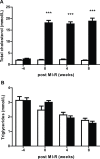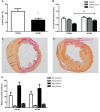Hypercholesterolemia affects cardiac function, infarct size and inflammation in APOE*3-Leiden mice following myocardial ischemia-reperfusion injury
- PMID: 31199833
- PMCID: PMC6570022
- DOI: 10.1371/journal.pone.0217582
Hypercholesterolemia affects cardiac function, infarct size and inflammation in APOE*3-Leiden mice following myocardial ischemia-reperfusion injury
Abstract
Background: Hypercholesterolemia is a major risk factor for ischemic heart disease including acute myocardial infarction. However, long-term effects of hypercholesterolemia in a rodent myocardial ischemia-reperfusion injury model are unknown. Therefore, the effects of diet-induced hypercholesterolemia on cardiac function and remodeling were investigated up to eight weeks after myocardial ischemia-reperfusion (MI-R) injury which was induced in either normocholesterolemic (NC-MI) or hypercholesterolemic (HC-MI) APOE*3-Leiden mice.
Methods: Left ventricular (LV) dimensions were serially assessed using parasternal long-axis echocardiography followed by LV pressure-volume measurements. Subsequently, infarct size and the inflammatory response were analyzed by histology and fluorescence-activated cell sorting (FACS) analysis.
Results: Intrinsic LV function eight weeks after MI-R was significantly impaired in HC-MI compared to NC-MI mice as assessed by end-systolic pressure, dP/dtMAX, and -dP/dtMIN. Paradoxically, infarct size was significantly decreased in HC-MI compared to NC-MI mice, accompanied by an increased wall thickness. Hypercholesterolemia caused a pre-ischemic peripheral monocytosis, in particular of Ly-6Chi monocytes whereas accumulation of macrophages in the ischemic-reperfused myocardium of HC-MI mice was decreased.
Conclusion: Diet-induced hypercholesterolemia caused impaired LV function eight weeks after MI-R injury despite a reduced post-ischemic infarct size. This was preceded by a pre-ischemic peripheral monocytosis, while there was a suppressed accumulation of inflammatory cells in the ischemic-reperfused myocardium after eight weeks. This experimental model using hypercholesterolemic APOE*3-Leiden mice exposed to MI-R seems suitable to study novel cardioprotective therapies in a more clinically relevant animal model.
Conflict of interest statement
The authors have declared that no competing interests exist.
Figures





Similar articles
-
Effects on cardiac function, remodeling and inflammation following myocardial ischemia-reperfusion injury or unreperfused myocardial infarction in hypercholesterolemic APOE*3-Leiden mice.Sci Rep. 2020 Oct 6;10(1):16601. doi: 10.1038/s41598-020-73608-w. Sci Rep. 2020. PMID: 33024178 Free PMC article.
-
Annexin A5 reduces infarct size and improves cardiac function after myocardial ischemia-reperfusion injury by suppression of the cardiac inflammatory response.Sci Rep. 2018 Apr 30;8(1):6753. doi: 10.1038/s41598-018-25143-y. Sci Rep. 2018. PMID: 29712962 Free PMC article.
-
Effect of hypercholesterolemia on myocardial necrosis and apoptosis in the setting of ischemia-reperfusion.Circulation. 2009 Sep 15;120(11 Suppl):S22-30. doi: 10.1161/CIRCULATIONAHA.108.842724. Circulation. 2009. PMID: 19752371 Free PMC article.
-
Clinical aspects of left ventricular diastolic function assessed by Doppler echocardiography following acute myocardial infarction.Dan Med Bull. 2001 Nov;48(4):199-210. Dan Med Bull. 2001. PMID: 11767125 Review.
-
Guidelines for in vivo mouse models of myocardial infarction.Am J Physiol Heart Circ Physiol. 2021 Dec 1;321(6):H1056-H1073. doi: 10.1152/ajpheart.00459.2021. Epub 2021 Oct 8. Am J Physiol Heart Circ Physiol. 2021. PMID: 34623181 Free PMC article. Review.
Cited by
-
The Influence of Metabolic Risk Factors on the Inflammatory Response Triggered by Myocardial Infarction: Bridging Pathophysiology to Treatment.Cells. 2024 Jun 29;13(13):1125. doi: 10.3390/cells13131125. Cells. 2024. PMID: 38994977 Free PMC article. Review.
-
Adeno-Associated Virus-Mediated Gain-of-Function mPCSK9 Expression in the Mouse Induces Hypercholesterolemia, Monocytosis, Neutrophilia, and a Hypercoagulative State.Front Cardiovasc Med. 2021 Sep 22;8:718741. doi: 10.3389/fcvm.2021.718741. eCollection 2021. Front Cardiovasc Med. 2021. PMID: 34631822 Free PMC article.
-
Phosphorylcholine Antibodies Preserve Cardiac Function and Reduce Infarct Size by Attenuating the Post-Ischemic Inflammatory Response.JACC Basic Transl Sci. 2020 Dec 2;5(12):1228-1239. doi: 10.1016/j.jacbts.2020.09.012. eCollection 2020 Dec. JACC Basic Transl Sci. 2020. PMID: 33426378 Free PMC article.
-
Mouse models of atherosclerosis and their suitability for the study of myocardial infarction.Basic Res Cardiol. 2020 Nov 30;115(6):73. doi: 10.1007/s00395-020-00829-5. Basic Res Cardiol. 2020. PMID: 33258000 Free PMC article. Review.
-
Single cell transcriptomics profiling of the stromal cells in the pathologic association of ribosomal proteins in the ischemic myocardium and epicardial fat.Cell Tissue Res. 2025 Feb;399(2):173-192. doi: 10.1007/s00441-024-03933-3. Epub 2024 Dec 6. Cell Tissue Res. 2025. PMID: 39641799 Free PMC article.
References
-
- LaRosa JC, Hunninghake D, Bush D, Criqui MH, Getz GS, Gotto AM Jr., et al. The cholesterol facts. A summary of the evidence relating dietary fats, serum cholesterol, and coronary heart disease. A joint statement by the American Heart Association and the National Heart, Lung, and Blood Institute. The Task Force on Cholesterol Issues, American Heart Association. Circulation. 1990;81:1721–1733. 10.1161/01.CIR.81.5.1721 - DOI - PubMed
Publication types
MeSH terms
Substances
Associated data
LinkOut - more resources
Full Text Sources
Medical
Miscellaneous

